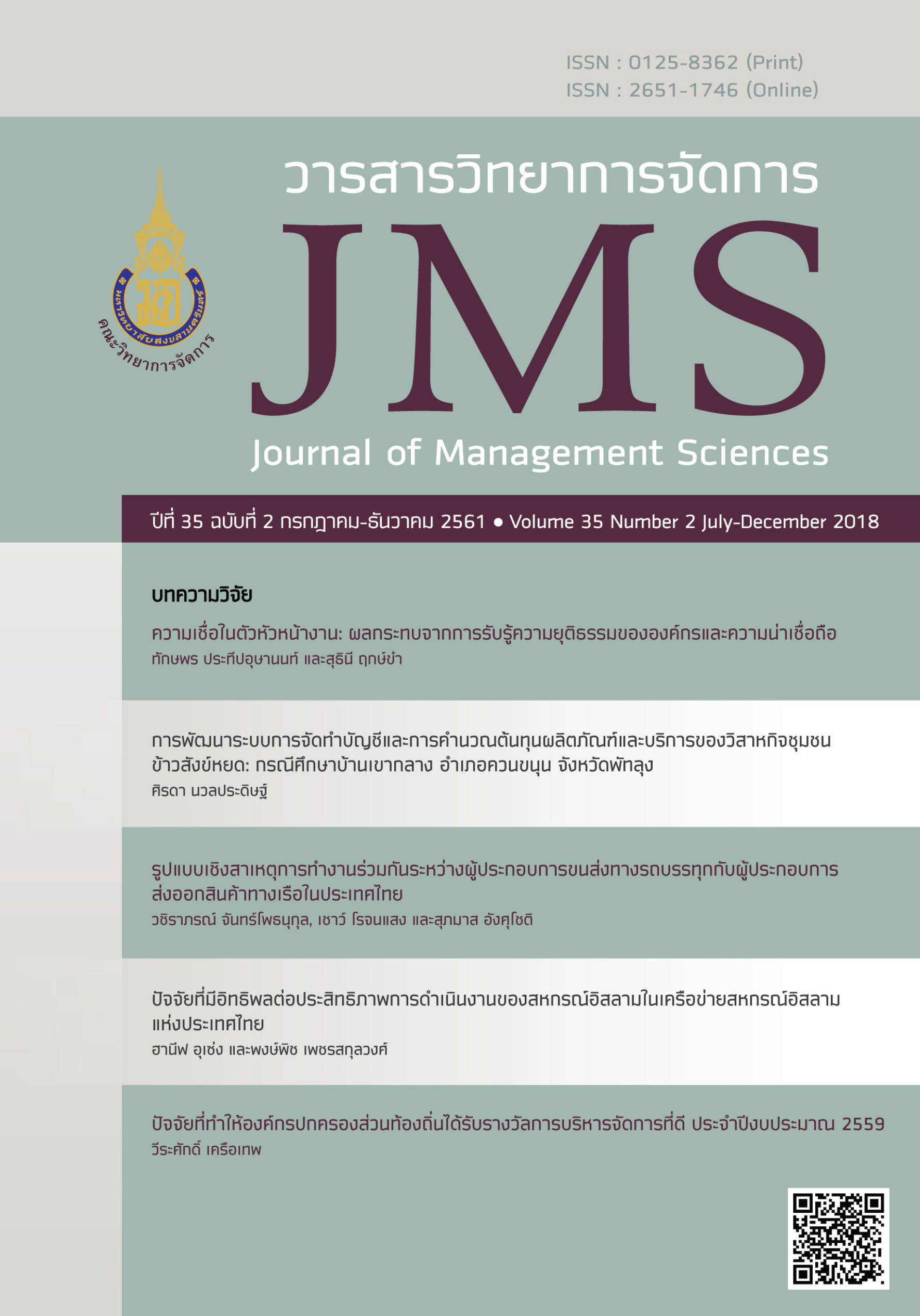รูปแบบเชิงสาเหตุการทำงานร่วมกันระหว่างผู้ประกอบการขนส่งทางรถบรรทุกกับผู้ประกอบการส่งออกสินค้าทางเรือในประเทศไทย
Main Article Content
บทคัดย่อ
การทำงานร่วมกันระหว่างบริษัทมีอิทธิพลต่อผลการดำเนินงาน ซึ่งความสัมพันธ์นี้อาจเป็นสิ่งสำคัญในการช่วยให้ผู้บริหารเข้าใจถึงรูปแบบการทำงานร่วมกันที่ดีที่สุด การวิจัยนี้จึงนำเสนอรูปแบบเชิงสาเหตุการทำงานร่วมกันที่ส่งผลต่อผลการดำเนินงานของกิจการระหว่างผู้ประกอบการขนส่งทางรถบรรทุกกับผู้ประกอบการส่งออกสินค้าทางเรือในประเทศไทย ด้วยวิธีวิจัยแบบผสานวิธี โดยการวิจัยเชิงปริมาณเก็บข้อมูลด้วยแบบสอบถามจากกลุ่มตัวอย่างผู้ประกอบการขนส่งทางรถบรรทุก 149 ราย และผู้ประกอบการส่งออกสินค้าทางเรือ 165 ราย วิเคราะห์ข้อมูลด้วยสถิติเชิงพรรณาและการวิเคราะห์สมการโครงสร้าง ส่วนการวิจัยเชิงคุณภาพใช้การสัมภาษณ์เชิงลึกจากผู้ให้ข้อมูลสำคัญ 9 ราย แล้วนำมาวิเคราะห์เชิงเนื้อหา ผลการวิจัยพบว่า ความไว้วางใจมีอิทธิพลต่อผลการดำเนินงานของกลุ่มผู้ประกอบการขนส่งทางรถบรรทุกมากที่สุด ขณะที่ความไว้วางใจ การทำงานร่วมกันและความยั่งยืนมีอิทธิพลต่อผลการดำเนินงานของกลุ่มผู้ประกอบการส่งออกสินค้าทางเรือตามลำดับ อย่างไรก็ตาม ความผูกพันไม่มีอิทธิพลต่อผลการดำเนินงานของทั้งสองกลุ่ม ดังนั้น จึงสรุปได้ว่าในการทำงานร่วมกันผู้บริหารทั้งสองกลุ่มสามารถผลักดันผลการดำเนินงานโดยมุ่งเน้นความไว้วางใจ นอกจากนี้ ควรให้ความสำคัญต่อการสร้างความผูกพันทั้งระดับผู้บริหารและพนักงาน
Article Details

This work is licensed under a Creative Commons Attribution-NonCommercial-NoDerivatives 4.0 International License.
บทความที่ตีพิมพ์ถือเป็นลิขสิทธิ์ของวารสารวิทยาการจัดการ มหาวิทยาลัยสงขลานครินทร์ อย่างไรก็ตาม กองบรรณาธิการไม่สงวนลิขสิทธิ์ในการทำซ้ำ คัดลอก หรือเผยแพร่ แต่จะต้องอ้างอิงให้ถูกต้องตามหลักวิชาการ
References
Barney, J. (1991). Firm resources and sustained competitive advantage. Journal of Management, 17(1), 99-120.
Barratt, M. (2004). Understanding the meaning of collaboration in the supply chain. International Journal Supply Chain Management, 9(1), 30-42.
Cao, M., & Zhang, Q. (2011). Supply chain collaboration: Impact on collaborative advantage and firm performance. Journal of Operation Management, 29(3), 163-180.
Duffy, R., & Fearne, A. (2004). The impact of supply chain partnership on supplier performance. Journal of Logistics Management, 15(1), 57-71.
Elkington, J. (1994). Enter the Triple Bottom Line. Retrieved January 3, 2016, from https://www.johnelkington.com/archive/TBL-elkington-chapter.pdf.
Fawcett, S. E., Jones, S. L., & Fawcett, A. M. (2012). Supply chain trust: The catalyst for collaborative innovation. Business Horizons, 55(2), 163-178.
Fugate, B. S., Davis-Sramek, B., & Goldsby, T. J. (2009). Operational collaboration between shippers and carriers in the transportation industry. The International Journal of Logistics Management, 20(3), 425-447.
Gibson, B. J., Rutner, S. M., & Keller, S. C. (2002). Shipper-carrier partnership issues, ranking and satisfaction. International Journal of Physical Distribution & Logistics Management, 32(8), 669-681.
Goldratt, E. M. (1990). What is this Thing Called Theory of Constraints and How should it be Implemented? New York: North River Press.
Ha, B. C. (2007). Strategic Collaboration with Motor Carrier and the Effect on Managers' Perceptions of Firm Performance. Thesis (PhD.) George Washington University, United States of America.
Ha, B. C., Park, Y. K., & Cho, S. (2011). Suppliers' affective trust and trust in competency in buyers: Its effect on collaboration and logistics efficiency. International Journal of Operations & Production Management, 31(1), 56-77.
Hudnurkar, M., Jakhar, S., & Rathod, U. (2014). Factors affecting collaboration in supply chain: a literature review. Procedia-Social and Behavioral Sciences, 133, 189-202.
Karia, N. (2013). Green innovation in logistics industry: sustainability and competitive advantage. In K. S. Soliman (Ed.), IBIMA conference 20th (pp. 456-462). Kuala Lumpur: IBIMA.
Kasikorn Research Center (2017). Logistics businesses 4.0 push shipping. Retrieved October 19, 2017 from https://www.kasikornbank.com/th/business/sme/SMEKnowledge/article/KSMEAnalysis/Documents/TransportationWithLogistic40.pdf
Lai, K. H., Ngai, E. W. T., & Cheng, T. C. E. (2004). An empirical study of supply chain performance in transport logistics. International journal of Production economics, 87(3), 321-331.
Lai, K. H., & Wong, C. W. (2012). Green logistics management and performance: Some empirical evidence from Chinese manufacturing exporters. Omega, 40(3), 267-282.
Lambert, D. M., Emmelhainz, M. A., & Gardner, J. T. (1999). Building successful partnerships. Journal of Business Logistics, 20(1), 165-181.
Mentzer, J. T. (2001). Managing supply chain collaboration. Supply Chain Management, 83-84.
Min, S., Roath, A. S., Daugherty, P. J., Genchev, S. E., & Chen, H. (2005). Supply chain collaboration: what’s happing? The International Journal of Logistics Management, 16(2), 237-256.
Ministry of Commerce. (2017). Export structure. Retrieved March 2, 2017, from https://www2.ops3.moc.go.th/
Morgan R. M., & Hunt. S. D. (1994). The commitment-trust theory of relationship marketing. Journal of Marketing, 58(3), 20-38
Nyaga, G. N., Whipple, J. M., & Lynch, D. F. (2010). Examining supply chain relationships: do buyer and supplier perspectives on collaborative relationships differ? Journal of operations management, 28(2), 101-114.
Penrose, E. T. (1959). The Theory of the Growth of the Firm. New York: Sharpe.
Perotti, S., Zozini, M., Cagno, E., & Micheli, G. J. (2012). Green supply chain practices and company performance: the case of 3PLs in Italy. International Journal of Physical Distribution & Logistics Management, 42(7), 640-672.
Piboonrungroj, P., & Disney, S. M. (2012). Supply chain collaboration, inter-firm trust and logistics performance: Evidence from the tourism sector. Retrieved June 3, 2016, from https://ssrn.com/abstract=2050703
Premeaux, S. R. (2009). The Similarity of motor carriers’ and shippers’ perceptions of the carrier choice decision improve. Journal of the Transportation Research Forum, 48(1), 39-47.
Simatupang, T. M., & Sridharan, R. (2002). The collaborative supply chain. International Journal of Logistics Management, 13(1), 15-30.
Simatupang, T. M., & Sridharan, R. (2004). Benchmarking supply chain collaboration: An empirical study. Benchmarking: An International Journal, 11(5), 484-503.
Spekman, R. E., & Carraway, R. (2006). Making the transition to collaborative buyer–seller relationships: An emerging framework. Industrial Marketing Management, 35(1), 10-19.
Supply Chain Council. (2012). Supply Chain Operations Reference Model version 9.0. United States of American.
Wei, H. L., Wong, C. W., & Lai, K. H. (2012). Linking inter-organizational trust with logistics information integration and partner cooperation under environmental uncertainty. International Journal of Production Economics, 139(2), 642-653.
Williamson, O. E. (1979). Transaction-cost economics: The governance of contractual relations. Journal of Law and Economics, 22(2), 233–261.
Wiratchai N. (1999). LISRELL Model: Statistical Analysis for Research. Bangkok: Faculty of Education, Chulalongkorn University
Whipple, J. M., & Russell, D. (2007). Building supply chain collaboration: a typology of collaborative approaches. The International Journal of Logistics Management, 18(2), 174-196.
